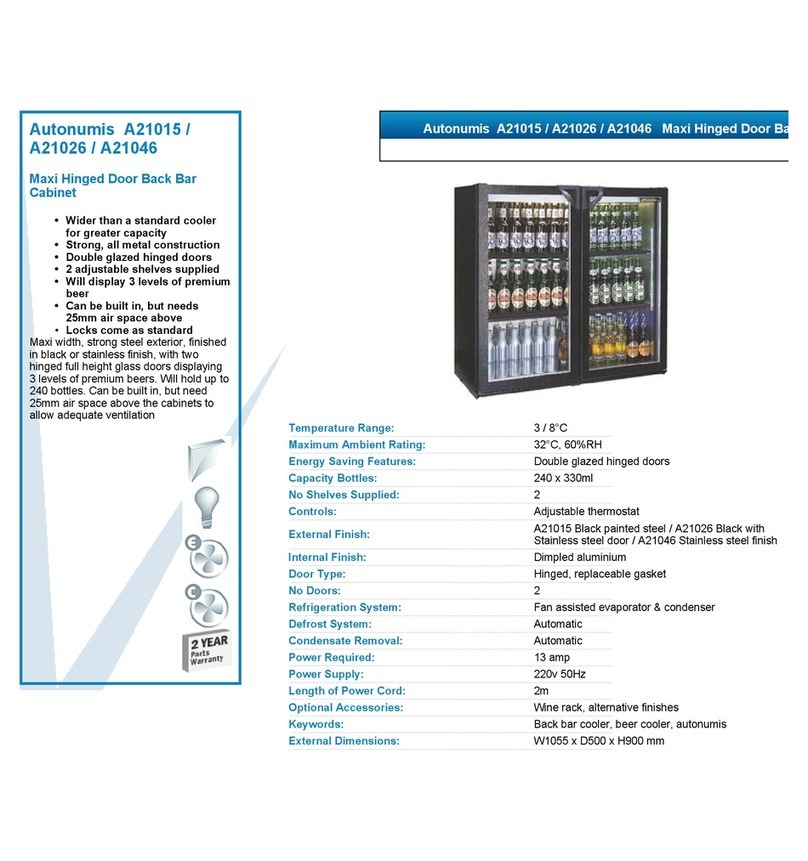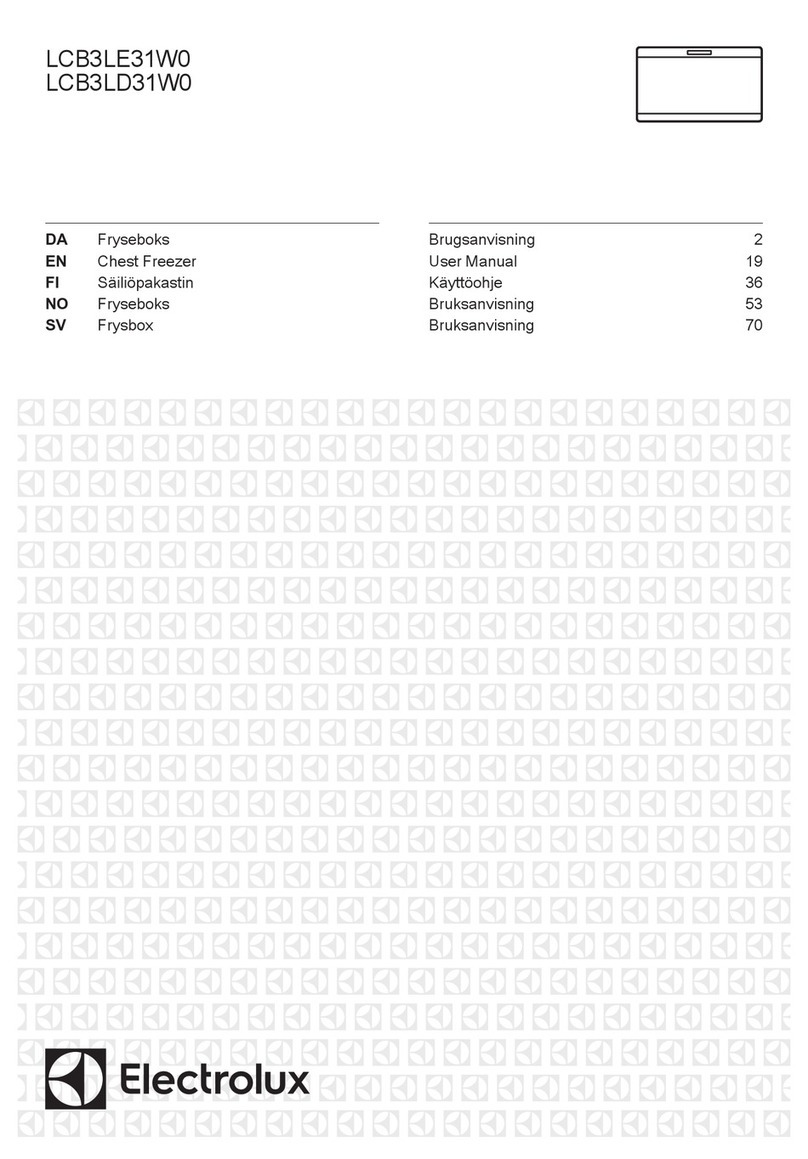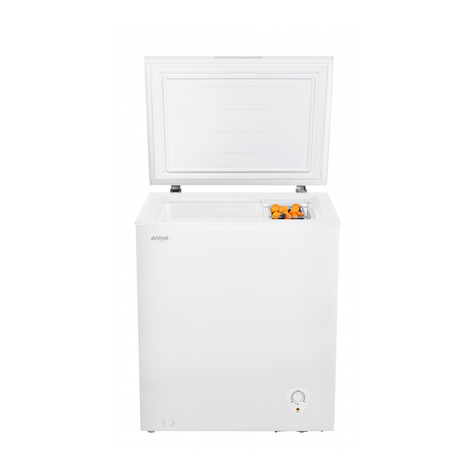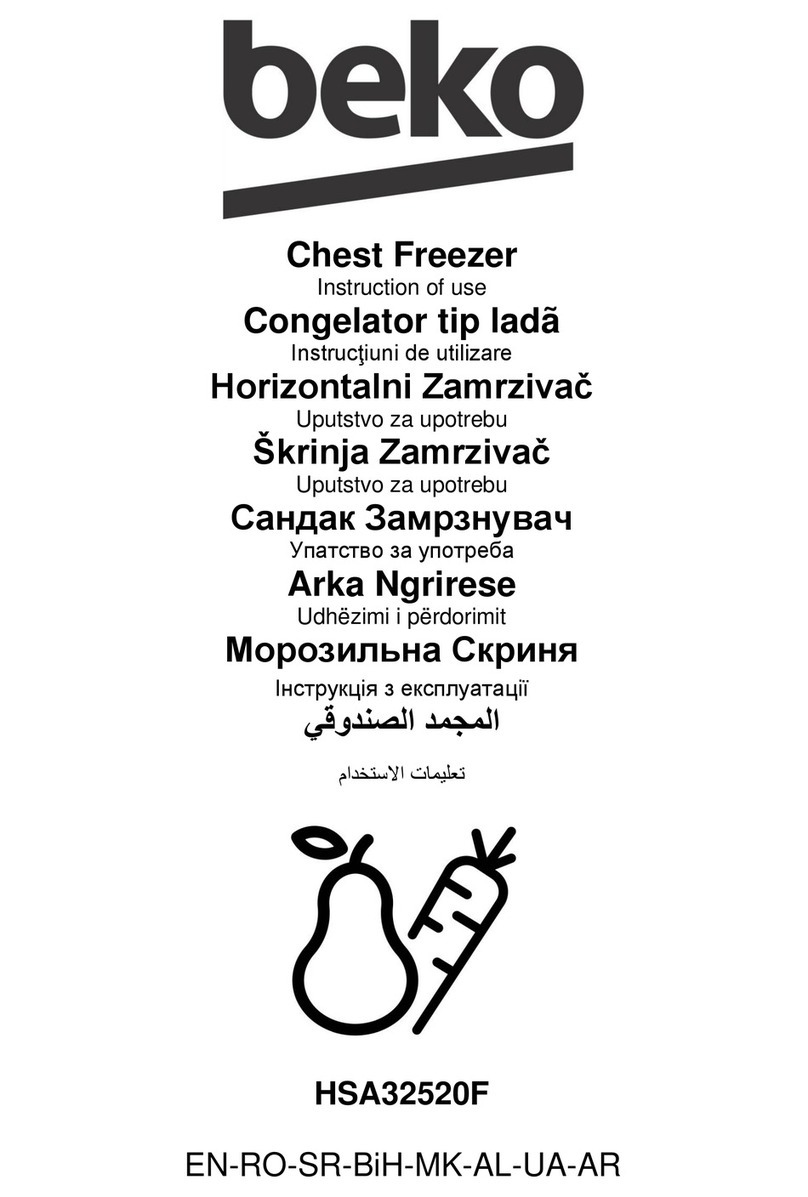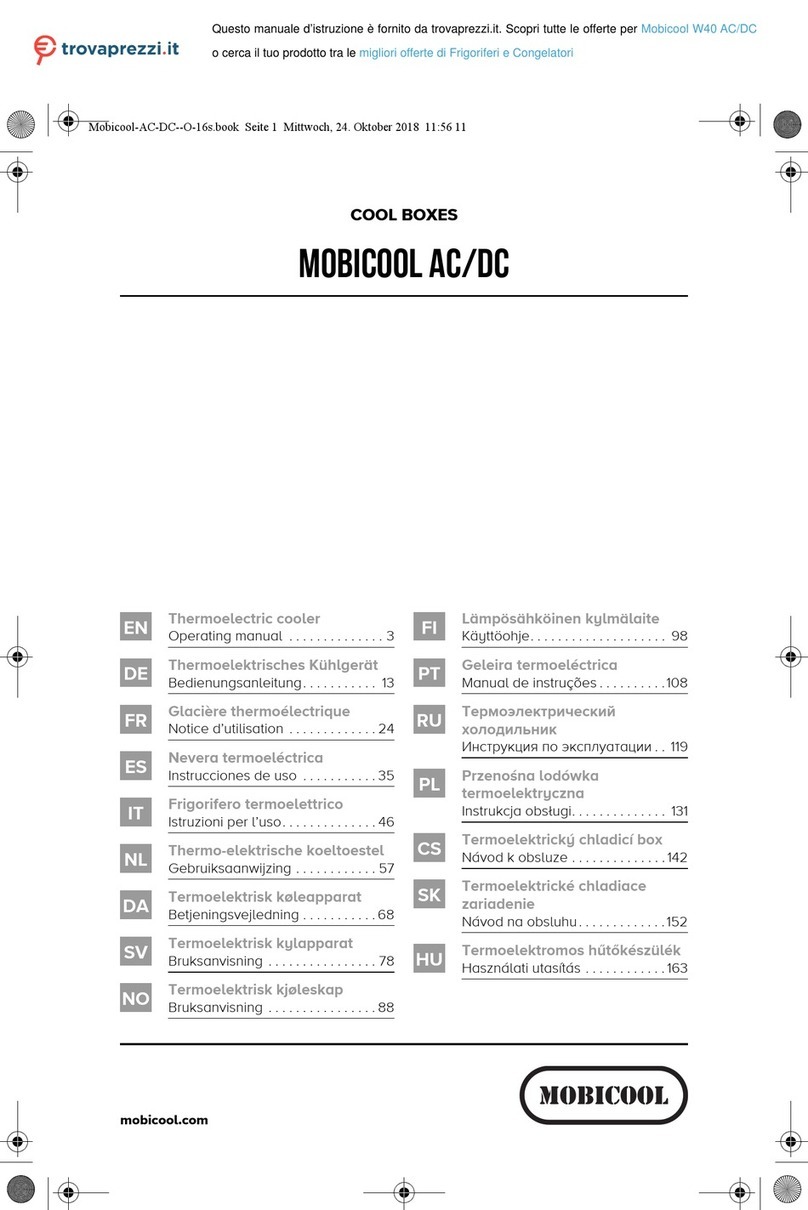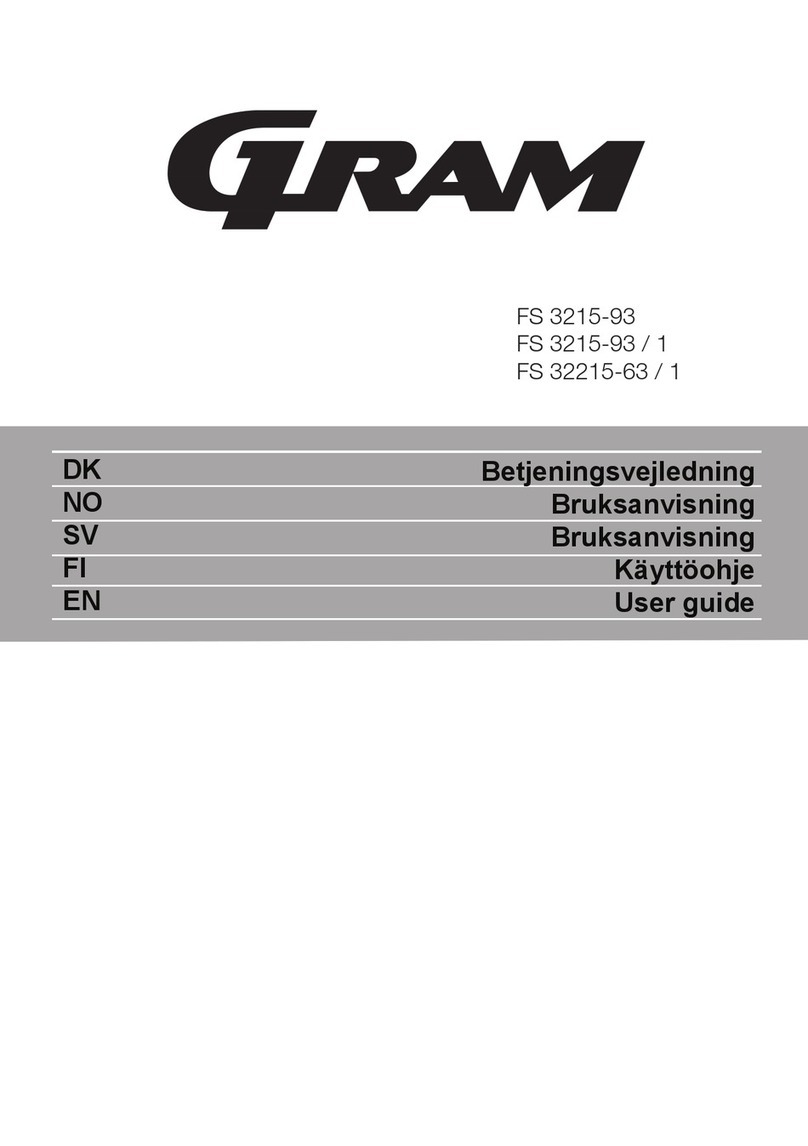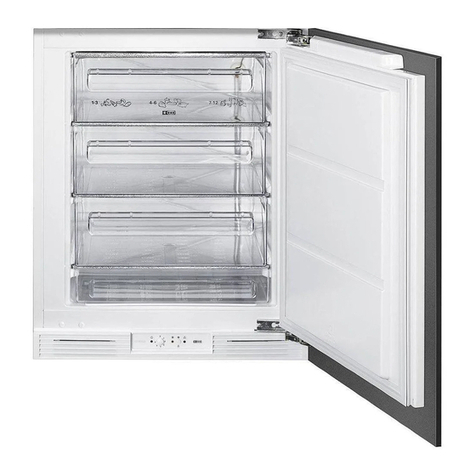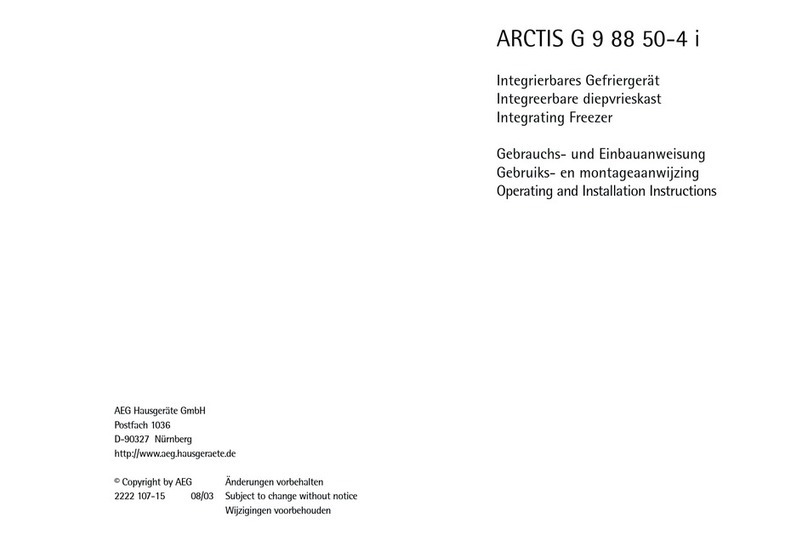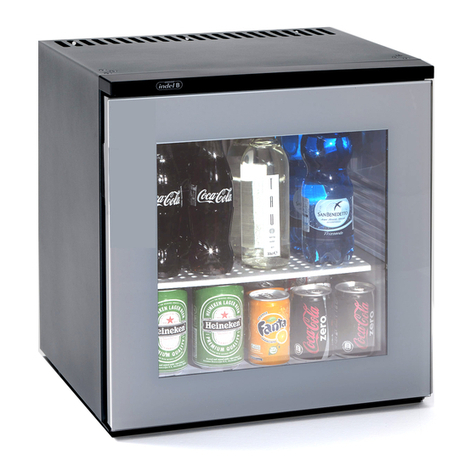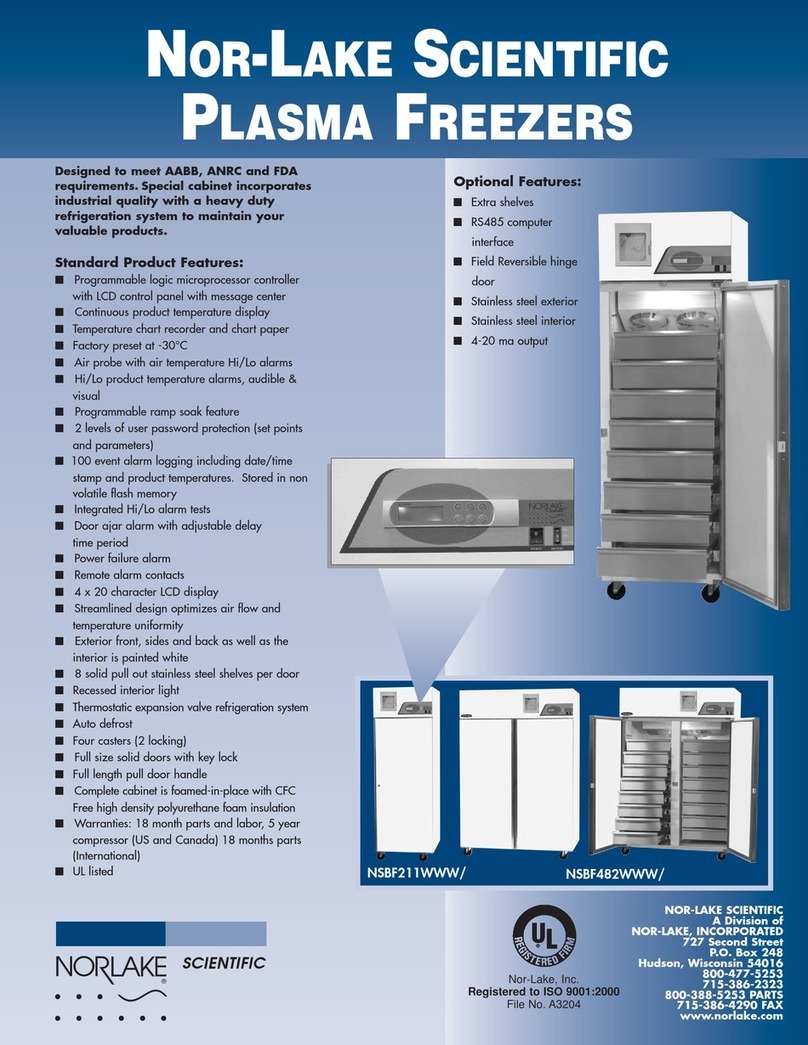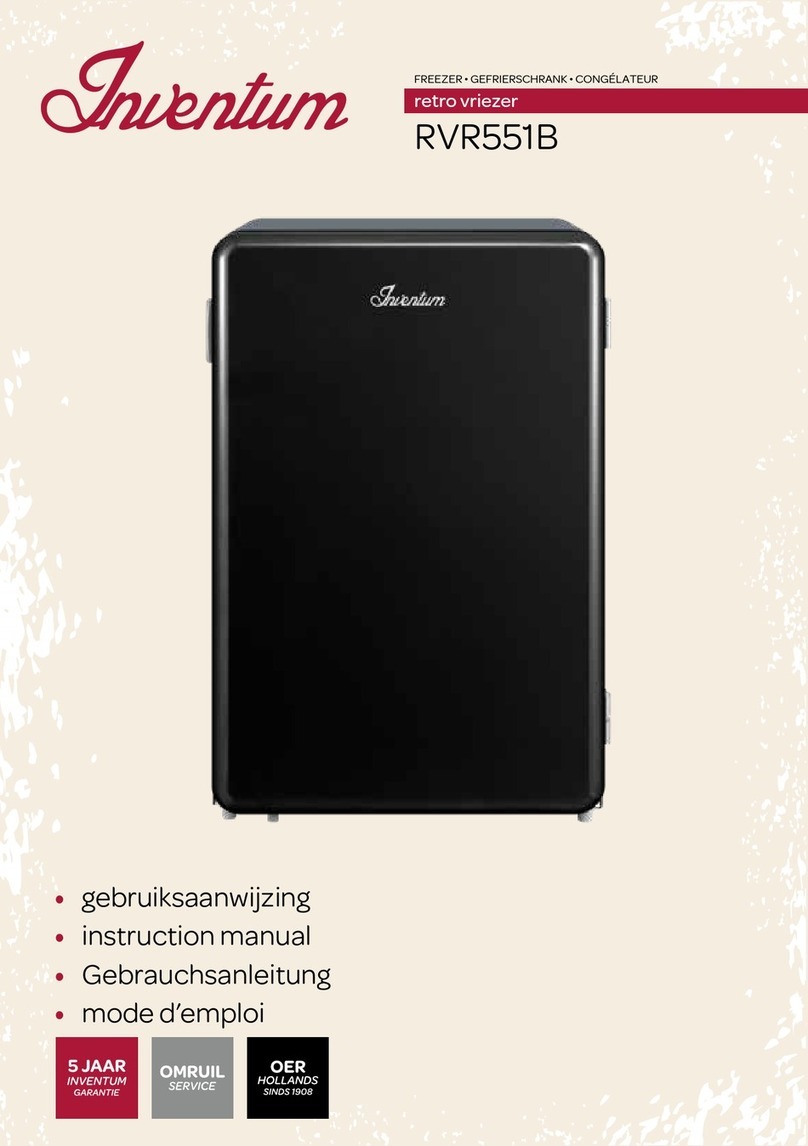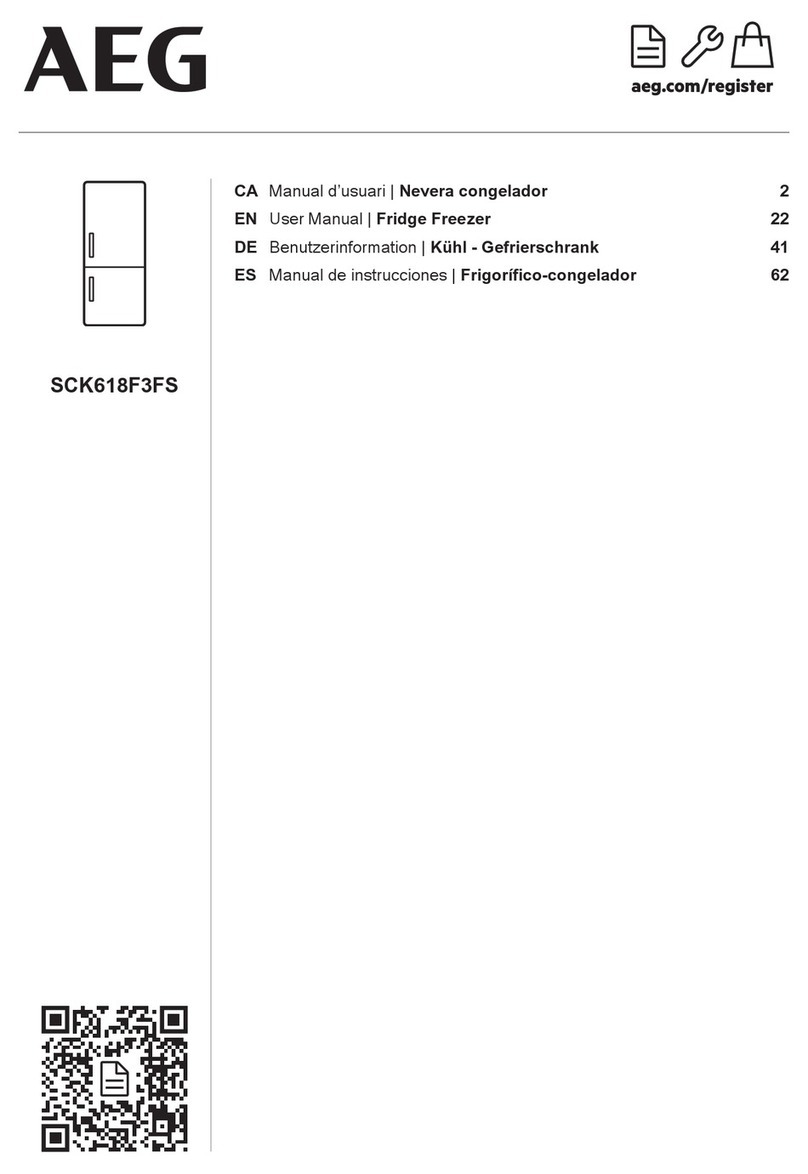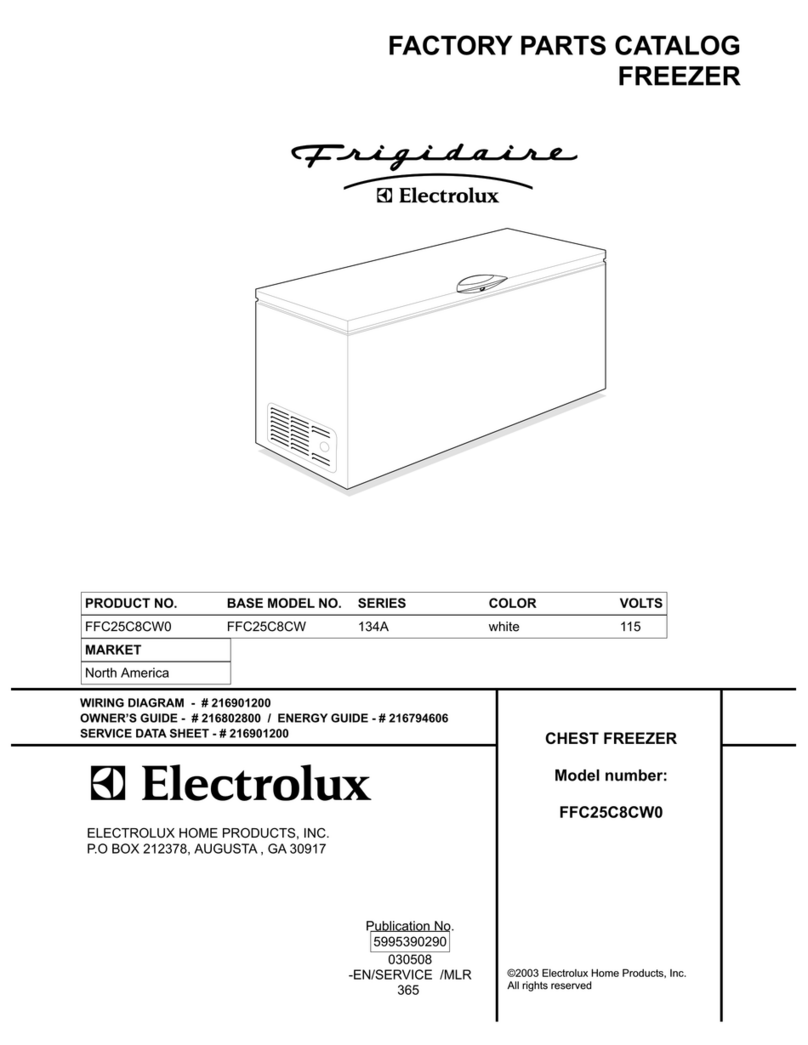Rieber TWF-C 3.0 User manual

Issue: 2018-03-07
Design example TWF-C 3.0
Design example TWF-C 3.0-PK
… longer lasting cooling effect with cooling pellets
Tray Transport Trolley
Diverse selection of tray transport trolleys for your special requirements.
Diverse additional features
The illustrations show examples of versions, which do not necessarily have to be included in the scope of supply.
Observe the operating instructions
Translation of the Original Operating Instructions
DOWNLOAD: USER MANUAL
QR code on type plate
EN

Contents
2
Rieber GmbH & Co. KG
Our solutions provide quality, safety
and, in particular, a high level of energy efficiency and cost effectiveness.
CHECK HACCP –In the area of HACCP documentation the CHECK CLOUD
platform offers the CHECK HACCP digital system, for simple, safe and transparent
temperature detection.
In addition to this, further digital features are possible in the area of hygiene and
service management. The automated digital answer to the analogue paper trail.
Contents
1Revision Index .................................................................................................................................................4
2Important information .....................................................................................................................................4
2.1 The components of the technical documentation................................................................................................ 4
2.2 Using this guide ................................................................................................................................................... 4
2.3 Representation conventions in the text................................................................................................................ 5
2.4 Structure of safety instructions ............................................................................................................................ 6
2.5 Navigation aid for making selections for your specific requirements................................................................... 6
3Safety instructions ..........................................................................................................................................7
3.1 General behaviour ............................................................................................................................................... 7
3.2 On use of electrical appliances............................................................................................................................ 7
3.3Operator's duties.................................................................................................................................................. 8
3.4 Personnel qualification requirements................................................................................................................... 9
3.5 Provide personal protective equipment (PPE) for personnel ............................................................................ 10
3.6 Appliance-specific safety instructions................................................................................................................ 10
3.6.1 Risks due to unstable position ...................................................................................................................... 10
3.6.2 Risks during transport of the appliance......................................................................................................... 10
3.6.3 Risks due to electricity .................................................................................................................................. 11
3.6.4 Risks due to trapped moisture and mould formation .................................................................................... 12
3.6.5 Risks of slipping/falling.................................................................................................................................. 12
3.6.6 Risks of tilting/toppling over .......................................................................................................................... 13
3.6.7 Risks due to being enclosed or suffocation in the appliance........................................................................ 13
3.6.8 Risks concerning the use of the appliance by children................................................................................. 13
3.6.9 Safety and monitoring devices...................................................................................................................... 14
3.7 Note the product identification and ensure its preservation .............................................................................. 15
3.8 Information about regulations to be followed..................................................................................................... 16
3.9 Instructions on behaviour in an emergency....................................................................................................... 16
4Designated use..............................................................................................................................................18
4.1 Generally, the following are intended uses for the product ............................................................................... 18
4.2 Prevent any predictable misuse and abuse....................................................................................................... 18
4.3Special intended use for TWF-H-AWT appliances............................................................................................ 19
4.4 Special intended use for TWF-AK appliances................................................................................................... 19
4.5 Tray solution for closed facility........................................................................................................................... 20

Contents
Rieber GmbH & Co. KG
3
5Description of appliance............................................................................................................................... 20
5.1 Designations ...................................................................................................................................................... 20
5.2 Technical data.................................................................................................................................................... 22
5.2.1 General information ...................................................................................................................................... 22
5.2.2 Types TWF-C 3.0.......................................................................................................................................... 23
5.2.3 Types TWF-C 3.0-PK.................................................................................................................................... 24
5.2.4 Types TWF-H-AWT ...................................................................................................................................... 26
5.2.5 Tray solution for closed facilities................................................................................................................... 27
5.3 Optional features, accessories .......................................................................................................................... 28
5.4 Rieber system crockery ..................................................................................................................................... 32
5.4.1 Thermotray 1 and Thermotray 2 ................................................................................................................... 32
5.4.2 Combitray - insulated crockery ..................................................................................................................... 33
6Things to know at delivery ........................................................................................................................... 36
7Use ................................................................................................................................................................. 38
7.1 Safety information with regard to use................................................................................................................ 38
7.2 General instructions for use............................................................................................................................... 39
7.3 Types TWF-AK .................................................................................................................................................. 40
8Cleaning, Maintenance and Care ................................................................................................................. 42
8.1 Safety information relating to cleaning, maintenance and care ........................................................................ 42
8.2 Cleaning agents for stainless steel.................................................................................................................... 43
8.3 Choose the correct cleaning method................................................................................................................. 44
8.4 Overview............................................................................................................................................................ 46
9Troubleshooting............................................................................................................................................ 47
9.1 Notes on troubleshooting................................................................................................................................... 47
9.2 Disposing of your product.................................................................................................................................. 48
10 Warranty and liability .................................................................................................................................... 49
11 Excerpt from the EU Declaration of Conformity......................................................................................... 49
12 Index............................................................................................................................................................... 50
13 Contact Details .............................................................................................................................................. 51

Important information
4
Rieber GmbH & Co. KG
1Revision Index
Revision
Change
2016-03-30
Provisional new edition
2017-12-06
Series C has been changed; mobile kitchen company logo
2018-03-07_f1
Adjusted to new reconstruction
2Important information
2.1 The components of the technical documentation
Operating instructions for tray transport trolley
Separate instructions for CHECK HACCP
www.rieber.de
Select "Service" at the top of the display list.
Spare parts and necessary instructions.
www.rieber.de
Select "Customer Service" at the top of the display list.
The Rieber price guide provides information about a wide variety of accessories.
www.rieber.de
At the top of the display list, select: Search price guide
Or: Contact the manufacturer, Rieber, or your dealer
Do you wish to have the operating instructions in another language?
www.rieber.de
Select "Customer Service" at the top of the display list.
2.2 Using this guide
This guide contains important information about how you can use the appliance safely and
correctly.
Read the operating instructions before first using the product.
Keep this guide in a safe place and pass it onto the next owner should you
wish to part with the product.
Our customers often express the wish to have one compact guide instead of a number of different
guides for these product variants, which have similar functions.
If there are any shortcomings in your opinion, please do not hesitate to let us know. We endeavour
to become even better with your help.

Important information
Rieber GmbH & Co. KG
5
Please add your notes here
2.3 Representation conventions in the text
Lists are represented in this way.
Instructions on certain actions are represented in this way.
▌The result of the action is represented in this way.
See ‘. . . ’ cross-references are represented in this way.
NOTE
indicates potential damage to property without any personal injury.
Failure to observe this note can lead to material damage.
User tip
Useful information or tip
# Explanation of graphic symbols used
Empty weight
Maximum loading

Important information
6
Rieber GmbH & Co. KG
2.4 Structure of safety instructions
The signal words DANGER - WARNING - CAUTION classify the degree of risk of bodily injury in an actual
situation. You can avoid injury by complying with the behavioural rules provided.
The warning triangle symbol indicates a "General Danger".
DANGER
indicates imminent danger.
Failure to follow these warning instructions will result in serious bodily
injury or even death.
WARNING
indicates a potentially hazardous situation.
Failure to follow these warning instructions may cause serious bodily
injury or even death.
CAUTION
indicates a potentially harmful situation.
Failure to follow these warnings may cause minor bodily injury.
2.5 Navigation aid for making selections for your specific requirements
# Advantages at a glance
Diverse selection of tray transport trolleys for your special requirements.
CHECK HACCP –the digitisation and organisation system from Rieber, for a safe,
transparent and traceable process.
# Note for your order
The order no. can be supplemented by the order numbers of optional features.
Select accessories such as *Rieber system tableware' separately.
‘Optional features, accessories’, Page 28 et seqq.

Safety instructions
Rieber GmbH & Co. KG
7
3Safety instructions
This section covers residual risks and hazards associated with the intended use of the appliance. We have
provided a list of all generally valid safety instructions which must be followed.
In the following section, safety information relating to a particular operation or situation is placed before the
appropriate operation step or description of the situation.
The information provided here such as ‘Basic rules of conduct’, ‘Operator's obligations’ etc. only refers to the
legally required observance of requirements such as the Workplaces Ordinance (ArbStättV) according to
German law.
3.1 General behaviour
This appliance meets the current state of the art and complies with all acknowledged technical
safety-related regulations. Nevertheless hazards may still arise.
Only use this appliance when it is in fault-free condition and according to the
instructions in this user guide.
During all phases of the appliance's life please ensure that the appliance is safely
integrated into its environment.
Refrain from rearranging or changing the device.
3.2 On use of electrical appliances
Safety instructions according to EN 60745-1:
Work area
Keep your work area clean and tidy. A messy or unlit work area can cause accidents.
Keep children and other people away from the area when work is being carried out.
Electrical safety
The plug on the unit must fit in the socket. Do not modify the plug in any way. Never use an adapter
in combination with earthed appliances. Using an unmodified plug and a suitable socket will reduce
the risk of an electric shock.
Avoid bodily contact with earthed surfaces such as pipes, heating units, cookers and refrigerators.
The risk of an electric shock is greater when your body is earthed.
Keep the device away from rain or moisture. Allowing water to get into an electric appliance will
increase the risk of electric shock.
Do not use the cable for anything other than the intended purpose to disconnect the plug from the
socket. Always remove whilst holding onto the plug. Keep the cable away from heat, oil, sharp edges
or the moving parts of other appliances. Using damaged or tangled cables increases the risk of
electric shock.
When working with an electrical appliance outdoors, only use extension cables which are permitted
for outdoor use. Using an extension cable suitable for outdoor use reduces the risk of electric shock.
Potential risk of fire due to heat build-up. Unwind the cable from the cable drum to prevent a possible
heat build-up and/or cable fire. The coupling must have splash protection, must be made of rubber or
be rubber-coated.

Safety instructions
8
Rieber GmbH & Co. KG
Safety guidelines for persons
Be attentive and pay attention to what you are doing, act rationally when working with an electrical
appliance. Do not use the appliance when tired or under the influence of drugs, alcohol or
medication.
Just one moment of inattention whilst using the appliance can result in serious injury.
Make sure the appliance cannot be switched on unintentionally. Double check that the main switch is
in the "OFF" position before inserting the plug in the socket. Connecting the appliance to the power
supply while it is switched on can cause an accident.
Careful handling and use of electrical appliances
Never use an electrical appliance with a faulty switch. An electrical appliance which can no longer be
switched on or off is dangerous and must be repaired.
Keep unused electrical devices away from children. Do not allow the appliance to be used by
persons who are not familiar with it or persons who are not familiar with this user guide. Electrical
appliances are dangerous when in the hands of inexperienced persons.
Treat the device with care. Check that moving parts are functioning properly and do not block; check
whether parts are broken or damaged and impairing the functioning of the device. Have any
damaged parts repaired before using the appliance. Many accidents are caused by poorly-
maintained electrical appliances.
Use electrical appliances, accessories etc in accordance with these instructions and in a manner that
is specified for this particular appliance type. When using the appliance, please take into account the
working conditions and the work being carried out. Using electrical appliances for other uses than
that intended can lead to hazardous situations.
Service
Only have the device repaired by qualified and authorised staff. Only use original spare parts. In this
way you can ensure that the appliance remains safe.
3.3 Operator's duties
Operator
The operator is the person who operates the appliance for commercial or economic purposes either
himself/herself or lets others use it and bears the legal appliance responsibility for protection of the
user, staff or any third parties during operation.
Operator's duties
The appliance is used in commercial applications. For this reason, the operator of the appliance
must meet all legal duties relating to work safety.
In addition to the safety instructions in this guide, the safety, accident prevention and environmental
protection regulation applying to the application of the appliance must be complied with.
In particular, the following shall apply:
The operator must be familiar with the applicable work safety regulations and
identify, by carrying out a risk analysis, any additional hazards which are due to the
place where the appliance is used. These hazards must be addressed in the form of
operating instructions governing the operation of the appliance.
Throughout the period of use of the device the operator must check that the
operating instructions which he has compiled comply with the current regulations
and adapt them if necessary.
The operator must clearly regulate and define the responsibilities for installation,
operation, troubleshooting, maintenance and cleaning.
The operator must ensure that all employees who use the device have read and
understood these instructions. In addition, the operator must train the personnel and
inform them of the hazards involved at regular intervals.

Safety instructions
Rieber GmbH & Co. KG
9
The operator must provide the personnel with the necessary protective equipment
and issue mandatory instructions on wearing it.
In addition, the operator must ensure that the appliance is always in a perfect technical condition.
For this reason, the following shall apply:
The operator must ensure that the maintenance intervals defined in this guide are
obeyed.
The operator must regularly check all safety devices for functionality and
completeness.
The operator must ensure that the appropriate media connections are present.
The operator must ensure that structural safety measures are performed.
3.4 Personnel qualification requirements
Safe operation requires certain technical skills and personal qualification of each person.
The responsibility for organization lies with the ‘Designated Representative’
(operator).
According to EN 50110-1 a work supervisor is ‘a person who is appointed to take
direct responsibility for the performance of work. If necessary, this responsibility can
be assigned partly to other persons. [...] The designated representative must instruct
all persons involved in the work on all hazards which may not be obvious for them’.
The work may only be performed by ‘instructed persons’ who have been trained
accordingly. Training, instructions must be repeated, proper understanding must be
verified (ideally by way of an appropriate test).
Only ‘Qualified Staff’ are allowed to carry out repair work.
According to IEC 60204-1, skilled workers are 'People who, due to their relevant
training and experience, are able to recognize risks and avoid potential hazards.'
Electrical work may only be carried out by trained and experienced electricians.
Electro-technically instructed persons may only work under the supervision of a
qualified electrician.
Work on the cooling unit should only be carried out by authorised skilled personnel
like a refrigeration specialist or a member of the Rieber Customer Service.
Repairs during the warranty period may only be carried out by the Rieber service
department, otherwise any resulting claims may lapse. Please contact the
manufacturer's service department at Rieber.
Chapter ‘Warranty and liability’, page 49

Safety instructions
10
Rieber GmbH & Co. KG
3.5 Provide personal protective equipment (PPE) for personnel
The requirements for safety shoes are regulated by standards. The safety shoes in this case are intended to
protect the toes. S1 safety shoes are protective shoes with the requirement that a protective toecap is present.
As with S2 and S3 safety shoes, the protective toecap has a load capacity of 200 joules. These requirements
are regulated in EN 20345:2004 for safety shoes.
Ensure that the personnel wear the personal protective equipment appropriate to the
relevant situation.
Wear safety shoes to prevent injuries during transport of the appliance.
3.6 Appliance-specific safety instructions
This chapter describes general, appliance-specific safety instructions. In the following section, additional safety
information relating to a particular operation or situation is placed before the appropriate operation step or
description of the situation.
3.6.1 Risks due to unstable position
Avoid unintentional moving of the appliance and the resulting risks. Prevent the
appliance from rolling away accidentally using the two parking brakes. Only park the
device on flat surfaces.
Observe general rules for safety against overturning:
Load the appliance from bottom to top to increase safety against overturning.
Unload the appliance from top to bottom.
3.6.2 Risks during transport of the appliance
Keep the doors closed during transport.
Push the appliance using the pushing handles; this gives you direct access to the
casters and retainers.
Move the appliance with 2 people if necessary.
Risks due to uncontrollable forces and overall weight of the appliance. Do not use
the appliance on a sloping surface, only move it on a flat surface.
Avoid unintentional moving of the appliance and the resulting risks. Prevent the
appliance from rolling away accidentally using the two parking brakes. Only park the
appliance on flat surfaces.

Safety instructions
Rieber GmbH & Co. KG
11
Only park the appliance on objects if a guard rail (optional) is provided. Make
realistic decisions when ensuring that deposited objects cannot fall. Secure objects
if necessary, for example with lashing straps or transport straps. Do not exceed the
maximum loading on the top, maximum 20 kg.
NOTE
Do not lift or transport the appliance with material handling equipment or a lift truck,
as this could damage the underside.
Wear personal protective equipment (PPE) such as safety shoes to prevent injuries
such as crushing, for example due to toes being run over.
NOTE
Note the permissible step height, maximum 4 mm, otherwise the casters may be
damaged.
NOTE
Do not lift the appliance using the pushing handle, as this could cause damage.
3.6.3 Risks due to electricity
→ Applies to types TWF-AK (… with cooling device, active convection cooling)
Danger of electric shock. Always disconnect the power cable before transporting the
appliance.
Danger of electric shock. Keep the device away from rain or moisture. Allowing
water to get into an electric appliance will increase the risk of electric shock.
Install the electric connection cable in such a way that risks like falling over or
tearing off the cable, etc. are avoided.

Safety instructions
12
Rieber GmbH & Co. KG
3.6.4 Risks due to trapped moisture and mould formation
Water jet can wet insulation materials on the side, which would impair the insulation effect; mould
formation, unpleasant odours etc. could result.
TWF-C 3.0, TWF-C 3.0-PK, TWF-AK may only be wiped down with a moist cloth.
Do not expose to water jets.
In the event of moisture damage, dry the appliance in the heating cabinet if
necessary.
Maximum permissible temperature +45 °C.
In the event of mould formation, lock the appliance and arrange for a hygiene
specialist to carry out the necessary measures.
Take suitable measures against human error, for example against the risk of
confusing appliances with each other, as when cleaning.
‘Operator's duties’, page 8
3.6.5 Risks of slipping/falling
!
→ Applies to types TWF-C 3.0-PK
Collection tank for condensation
Slipping hazard. Risk of falling. Empty the collection tank for condensation in due
time.
The device can be brought to the right temperature in advance in a cold chamber or
heat cabinet, between +2 °C and +45 °C. Do not allow it to go below +2 °C.

Safety instructions
Rieber GmbH & Co. KG
13
3.6.6 Risks of tilting/toppling over
!
Secure the position of the door at the end positions with a door lock.
Do not tilt the device at the open door.
3.6.7 Risks due to being enclosed or suffocation in the appliance
→ applies to all appliances
Danger of suffocation if persons get shut inside the appliance. Secure the appliance
against children at play and people with limited sensory and mental abilities. Use in
public areas or for self-service is only permitted under constant supervision.
→ Applies to types TWF-AK (… with cooling device, active convection cooling)
Danger of suffocation if persons get locked in the appliance. Make sure persons with
limited sensory and mental ability have no access to the appliance.
3.6.8 Risks concerning the use of the appliance by children
This appliance may be used by children over 12 and by persons with limited
physical, sensory and intellectual abilities or a lack of experience and/or knowledge
if they are supervised or if they have been instructed in the safe use of the appliance
and have understood the resulting dangers.
Children may not play with the appliance. They could shut themselves inside it.
Cleaning and user maintenance may not be carried out by children without
supervision.

Safety instructions
14
Rieber GmbH & Co. KG
3.6.9 Safety and monitoring devices
# General
Design example TWF-C 3.0-PK
1 2x swivel casters with parking brake → secure appliance in position to prevent it from rolling
away and act as an ‘emergency brake’.
2 Collecting tank for condensation → Condensation running of the cooling pellets is collected.→
Applies to types TWF-C 3.0-PK.
3 Handle → for pushing the appliance. → Push the appliance using the pushing handle; this
gives you direct access to the casters and the parking brakes. If necessary ask someone to
help you.
There are two movable, long guard rollers on the grips to move the device. These are to
protect against pinching/squashing fingers/hands and also against damage from banging
against door locks.
4 Door rod with handle → The door self-locks. Open the door by taking hold of the handle and
pulling it up. Door stop in ed positions.
5 Ledges to fix position and prevent the tray from tipping
The lower 'encompassing bumper rail' protects against impact and avoids property
damage.
The upper 'encompassing bumper rail' (optional) provides additional protection
against property damage, e.g. during transportation by car.
# → Applies to types TWF-AK (… with cooling unit, active convection cooling)
The product switches itself off automatically in the event of a fault in the control
system..
To increase your safety we recommend that you install a residual current device
with a tripping current of 30 mA upstream of the appliance.
Every 6 hours an automatic defrosting operation takes place, which prevents the
evaporator from icing up; the condensation evaporates. The defrosting phase takes
around 20 minutes when the power to the appliance is switched on.
The defrosting LED (3) lights up.
‘Types TWF-AK’, page 40

Safety instructions
Rieber GmbH & Co. KG
15
3.7 Note the product identification and ensure its preservation
TWF-C 3.0
TWF-C 3.0-PK
TWF-AK
TWF-H-AWT
These product identifications can be ordered by request.

Safety instructions
16
Rieber GmbH & Co. KG
The 'collection tank for condensation' and its position in the appliance are not
marked.
The own weight of the appliance as well as the permissible loading are not marked
on the device.
3.8 Information about regulations to be followed
In addition to this user guide there are a range of health and safety and other regulationsthat are
relevant for the operation of this cooking station; these include HACCP food hygiene regulations for
example.
Maximum keep-warm time according to HACCP is 2 hours.
3.9 Instructions on behaviour in an emergency
Prepare first-aid measures. Scenarios:
Crushing of tips of toes due to being run over
Crushing of parts of the body during movement of the appliance
Contusions, stab and cut injuries from falling tableware; cutlery or sharp, sharp-
edged object.
Risk of burns and scalds from hot parts such as food, soups etc.
Sliding/falling Draining condensation can make the floor slippery if the collection
tank for condensation is not emptied.
An emergency could be a fire in the proximity. Make sure you take precautionary measures.
For electrical appliances: Switch the appliance off immediately in an emergency. Unplug the mains
plug. Switch off the fuse if necessary.
Store the emergency equipment, including the relevant instructions, at a readily accessible place
near the place of use.
Instructions on dealing with faults in the refrigeration system
→ Applies to types TWF-AK (… with cooling device, active convection cooling)
Work at the cooling unit may only be carried out by refrigeration experts.
Refrigerant in the cooling circuit: Contact can cause eye irritation and cardiovascular disorders.
Fire-fighting measures:
Use water spray jet or water mist, alternatively carbon dioxide or powder
extinguisher.
Call the fire brigade; Use self-contained breathing apparatus.

Safety instructions
Rieber GmbH & Co. KG
17
Information on the insulating material between inner and outer sheet / carcass:
Polyurethane rigid foam board
This information is intended for the operator in the event of a large fire.
In the event of a fire thick black smoke develops, which contains hazardous decomposition
products. Breathing in the decomposition products can cause a health hazard. In the event of a fire
wear self-contained breathing apparatus if necessary.
Suitable extinguishing media: Alcohol-resistant foam, carbon dioxide (CO2), dry powder, water
spray jet
Information on Armaflex insulation material
→ Applies to types TWF-AK (… with cooling device, active convection cooling)
This information is intended for the operator in the event of a large fire.
This appliance contains around 1 m2Armaflex, for sealing lines. Armaflex insulation material can
burn and release toxic fumes.
First-aid measures:
Call a doctor.
Move to fresh air after inhalation.
In the event of contact with the skin wash off with water and soap.
After eye contact remove contact lenses, hold eyelids open and rinse for at least
15 minutes with plenty of clean, running water.
Call a doctor.
Fire-fighting measures:
Water spray jet; Carbon dioxide (CO2); Dry powder; Foam
Use self-contained breathing apparatus. Wear protective suit.

Designated use
18
Rieber GmbH & Co. KG
4Designated use
This chapter provides information on the intended use of the product and warns against foreseeable misuse or
abuse, for your safety.
4.1 Generally, the following are intended uses for the product
For mobile meal services in chain and general catering, hotels and restaurants; also
for managed care facilities and schools. Food delivery / food distribution in building.
Only keep either hot or cold food in an appliance at any one time.
To prevent injuries, any use in public and/or for self-service is only allowed under
supervision.
Push the appliance using the pushing handle.
Only spare parts that have been approved and specified by the manufacturer may
be used. Certain repairs may only be carried out by the Rieber service department.
The intended use includes compliance with the technical data.
The person responsible for the work, e.g. the chef, defines how the tray transport
trolley is actually used and is responsible for such use.
For use only by appropriately trained and suitable operating personnel.
4.2 Prevent any predictable misuse and abuse
Water jet can wet insulation materials on the side, which would impair the insulation effect; mould
formation, unpleasant odours etc. could result.
→ Applies to: TWF-C 3.0, TWF-C 3.0-PK, TWF-AK
TWF-C 3.0, TWF-C 3.0-PK, TWF-AK should only be wiped with a moist cloth and
be kept away from the effects of liquids. Do not expose to water jets.
Page 15, 38, 42
Deliver/distribute food packaged/wrapped.
Do not lift the appliance using the pushing handle, as this could cause damage.
Push the appliance using the pushing handle.
Do not pull or push the appliance over sharp edges, danger of material damage.
Do not use this appliance on poor floor conditions.
▌We are not able to rule out the possibility of marks appearing on the floor due to friction
with casters or the formation of scratches due to split cracks in the casters, for example.
▌We are not able to rule out the possibility that the casters may be damaged or become
unusable due to thresholds or sharp edges on the floor.
Only transport the appliance in its correct position (operating position).

Designated use
Rieber GmbH & Co. KG
19
Machine-aided transport, using fork lift trucks or lift trucks, is not permitted. The
transportation of TWF-H-AWT may differ depending on the specific order.
Not intended for private domestic use.
Do not use the appliance in aggressive ambient conditions, for example extremely
salt-laden air such as close to the sea or at a swimming pool with a chlorinated
atmosphere, as this could damage the stainless steel.
Incorrect cleaning can substantially and irreparably damage the stainless steel
surfaces.
‘Choose the correct cleaning method’, page 44
4.3 Special intended use for TWF-H-AWT appliances
# Intended uses of the product are as follows:
TWF-H-AWT stands for order-specific special versions in hygiene design H3 for
'automatic goods transport'. This can be, for example, a flexible transport system
(FTS) or an electric overhead conveyor (EHB).
Use the device only for the contractually agreed designation.
# Avoid incorrect use and misuse:
A frequently requested use of the product is the transportation of trays of all
variants, sterile goods, pharmaceutical goods, dirty and dirty laundry and waste.
Only use the appliance for the intended or contractually agreed purpose.
The operator of the appliance must meet all legal duties relating to work safety. It
may be necessary to provide special instructions for the operating staff. A special
product identification may be advisable; If necessary, contact the manufacturer.
‘Operator's duties’, page 8
4.4 Special intended use for TWF-AK appliances
# Intended uses of the product are as follows:
For keeping portioned (refrigerated) food cold, not for cooling food down.
The appliance can be brought to temperature beforehand in a cold chamber, down
to +2 °to C.
This appliance is intended for use up to an altitude of 4000 metres above sea level.
# Avoid incorrect use and misuse:
Fill TWF-AK with sufficiently pre-chilled food. Otherwise condensation could run off
and damage the parquet floor. Slipping hazard.
automatic defrosting process. Comply with the HACCP regulations.
‘Types TWF-AK’, page 40

Description of appliance
20
Rieber GmbH & Co. KG
4.5 Tray solution for closed facility
# Intended uses of the product are as follows:
For close facilities, for example a hospital for the mentally ill or a prison. Special
solution.
Safe meal trays, containers, lids, set
Chapter ‘Tray solution for closed facilities’, page 27
5Description of appliance
This chapter has interesting facts about the set-up and functionality of this appliance
5.1 Designations
Design example TWF-C 3.0-PK
Design example TWF-C 3.0
1 2x caster with parking brake → secures appliance in position to prevent it from rolling away
and acts as 'emergency brake'
2 Collection tank for condensation →applies to TWF-C 3.0-PK
3 Cooling pellets for chilling (accessories) → applies to TWF-C 3.0-PK
4 Pushing handle →for pushing the TWF
5 Door rod with handle →The door self-locks. Otherwise, take hold of the handle and
open/close. Door stop in ed positions.
6 Guard rail (optional)
7 Bumper rail → to prevent damage to property during collisions,
(impact protection at top is optional)
8 Dividing wall → filled with cooling pellets for type TWF-C 3.0-PK
9 Deep-drawn support ledges and anti-tipping mechanisms, to prevent the tray from tipping
10 Fixed caster, 2x
This manual suits for next models
1
Table of contents
